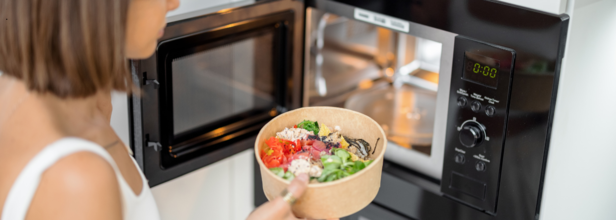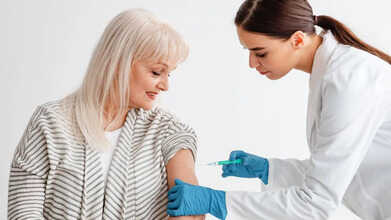- Health Conditions A-Z
- Health & Wellness
- Nutrition
- Fitness
- Health News
- Ayurveda
- Videos
- Medicine A-Z
- Parenting
How Safe Is It To Use Microwave For Reheating Food?

Microwaves are a common appliance in every household now. You will see it in kitchens of not just houses, but offices, cafeterias, and co working space. However, there are studies that show that heating food in a microwave could be a health concern. While it does come handy, there are questions about harmful radiation and nutrient loss and heating safety that still linger.
Does Microwave Destroy The Nutrients In Food While Heating?
Some research suggests that microwaving may cause nutritional loss, particularly in vegetables. For example, studies have shown that microwaving broccoli with water diminishes its flavonoid content, which are anti-inflammatory compounds. However, experts note that cooking method and duration have a significant influence on nutrient retention.
Surprisingly, several studies indicate that microwaving preserves more nutrients than traditional cooking methods. A study comparing microwaved versus oven-cooked ready meals found that the microwaved version contained somewhat more vitamin C. Another study discovered that microwaving some vegetables, such as broccoli and green beans, may retain more beneficial compounds than boiling.
Ultimately, the nutrient loss really vary on the type of food which is being heated and how it is being cooked. Experts also recommend using minimal water and shorter cooking times to maximize the nutrient retention.
Is Heating In Plastic Safe?
Plastic containers and heating food in it, has always been a topic of debate. While containers do come with microwave-safe stamps, is it really safe to heat them with food?
According to research, when certain plastics are subjected to heat, they produce compounds such as phthalates and bisphenol A (BPA). These substances have been associated to hormonal disturbance, metabolic problems, and perhaps reproductive concerns.
A study also took in account over 400 plastic food containers that were microwave-safe and found that most of them leaked hormone-disrupting chemicals. These are phthalates, warn experts, which are commonly used in food packaging and can interfere with body's hormonal balance, and increase risk of diabetes or even high blood pressure.
Additionally, BPA exposure has been associated with fertility issues and immune system disruptions.
So, what can be done instead?
To minimize this risk, experts recommend using glass or ceramic container when microwaving foods. If you must use a plastic container, make sure the container is not damaged or old, as they are more prone to leach harmful chemicals.
What About The Radiation?
Concerns about microwave radiation have been largely debunked by decades of research. Microwaves use non-ionizing radiation, which does not have enough energy to damage DNA or cause cancer. The electromagnetic waves used in microwaves are similar to those from radios and light bulbs.
Experts emphasize that microwave ovens are designed to contain radiation, preventing exposure. As long as the microwave is in good condition and the door seals properly, there is no significant health risk from microwave radiation.
Other Concerns
Microwaving food could sometimes also lead to uneven cooking and it can create some risks to food safety. Thus, experts advertise to use microwave only to reheat the food and not to actually cook raw food. For safe reheating, food should reach at least 82°C (176°F) throughout to kill bacteria.
Flu Cases Surge Across The US: How Long Does The Super Flu Remain Contagious?

Credits: Canva
Flu Symptoms: Seasonal infections are spreading across the United States just as the holiday travel rush gets underway, worrying health officials about fresh spikes during family get-togethers. Flu and norovirus cases are rising in several states, while COVID-19 continues to circulate at lower but consistent levels. Together, these illnesses are adding strain on hospitals as millions of people plan to travel in the days ahead.
Flu: What Is Super Flu?
“Super flu” is not a clinical term, but it is often used to describe a flu season that feels more aggressive or spreads faster than usual. This is typically linked to a dominant strain of influenza A. The current surge is being driven by a mutated influenza A strain known as H3N2 subclade K. Health officials say this strain has become the leading flu variant in the US, accounting for roughly 89 percent of H3N2 samples analysed since late September, according to genetic sequencing data from the Centers for Disease Control and Prevention (CDC).
This variant emerged after the 2025–26 flu vaccine was formulated, meaning the vaccine may not be as closely matched as in earlier seasons. While the shot still offers protection against severe disease, experts note that the mismatch could allow the virus to spread more easily.
Flu Symptoms 2025: What Symptoms Should People Watch For?
The symptoms seen in the current flu wave are largely familiar. People may develop fever, chills, extreme tiredness, cough, and body aches. Doctors, however, caution that the wider spread could result in more serious cases, particularly among people who are at higher risk.
CDC estimates indicate that the US has already seen about 4.6 million flu cases this season, along with nearly 49,000 hospital admissions and around 1,900 deaths. Flu activity increased sharply in mid-December, with test positivity jumping from 8.1 percent to 14.3 percent within a single week.
Flu Symptoms 2025: How To Reduce The Risk
Doctors recommend staying home when feeling unwell, washing hands often, especially to limit norovirus spread, and considering vaccination against flu and COVID-19. Even when the strain match is not ideal, experts stress that vaccines remain crucial in reducing the risk of severe illness, hospitalisation, and death.
Flu Cases In The US: How Contagious Is Superflu?
In terms of how easily it spreads, it behaves much like regular flu, which is known to be highly contagious.
Someone with flu can pass on the virus from around one day before symptoms appear and continue to be contagious for five to seven days after becoming sick. Children, older adults, and those with weakened immune systems may remain infectious for a longer period.
The virus mainly spreads through respiratory droplets released when an infected person coughs, sneezes, speaks, or breathes near others. It can also spread through contact with contaminated surfaces, followed by touching the mouth, nose, or eyes. Crowded indoor settings, poor airflow, and close contact make transmission far more likely, which explains why flu spreads quickly during peak season.
What makes a so-called “super flu” seem more contagious is not a new way of spreading, but higher case numbers, quicker community transmission, and stronger symptoms, all of which increase coughing, fever, and the amount of virus released.
These 3 Persistent Changes In Your Feet May Be A Sign Of High Cholesterol

Credits: Canva
Raised cholesterol levels do more than strain the heart. They can sharply limit blood circulation to the arms and legs, increasing the risk of serious health problems. High cholesterol is already known to raise the chances of heart attacks and strokes, which makes recognising early warning signs especially important.
Low-density lipoprotein, commonly known as LDL or “bad” cholesterol, builds up along artery walls. Over time, this build-up narrows the blood vessels and increases the likelihood of blockages that can lead to cardiac arrest. According to the NHS, diets high in fatty foods, frequent alcohol intake, and a lack of physical activity are among the main reasons cholesterol levels rise.
Why Symptoms May Appear in the Feet
Although cholesterol is often detected through medical tests, warning signs can sometimes surface in unexpected parts of the body, including the feet. Paying attention to these changes can help doctors identify peripheral artery disease, or PAD, which develops when fatty deposits restrict blood flow. This has been reported by Surrey Live.
The British Heart Foundation explains that as circulation worsens, the body struggles to supply enough oxygen, nutrients, and blood to the skin and surrounding tissues. This problem is most noticeable in the feet, as they are the farthest point from the heart.
Three Serious Foot Symptoms Linked to High Cholesterol
There are three major signs of high cholesterol that may show up in the feet:
- Pain
- Ulcers
- Gangrene
Other PAD Symptoms to Look Out For
People with peripheral artery disease may also notice additional changes, such as:
* Loss of hair on the legs or feet
* Weakness or numbness in the legs
* Toenails that grow slowly or become brittle
* Open sores on the feet or legs that take a long time to heal
* Changes in skin colour, including pale or bluish tones
* Skin that looks shiny
* Erectile dysfunction in men
* Loss of muscle mass in the legs
Lowering cholesterol levels is essential to reduce the risk of PAD and other complications associated with high cholesterol.
It is important to confirm high cholesterol with a healthcare professional, as many people experience few or no symptoms.
A blood test remains the most reliable way to detect high cholesterol, which often goes unnoticed without screening.
When Symptoms Become an Emergency
Symptoms such as foot pain, ulcers, and gangrene may signal a severe form of PAD known as critical limb ischaemia. The British Heart Foundation warns that this condition needs urgent medical treatment to help prevent limb loss.
If a doctor suspects high cholesterol, the NHS advises that a blood test will usually be recommended.
How Cholesterol Is Tested
There are two main ways cholesterol levels can be checked:
* A blood sample taken from the arm
* A finger-prick test
If results confirm high cholesterol, a GP will talk through ways to bring levels down, which may include changes to diet or prescribed medication.
Diet Changes That Can Help
Adjusting what you eat is often one of the most effective ways to reduce cholesterol, as diet is a common cause of high levels. One practical step is to cut back on saturated fats and replace them with unsaturated fats.
Saturated fats are commonly found in foods such as fatty cuts of meat, butter, cheese, and lard. Unsaturated fats, on the other hand, are present in vegetables, nuts, seeds, and plant-based oils.
Apart from that, increasing physical activity can also help manage cholesterol and support overall heart health.
UK health guidelines recommend that adults aim for at least 150 minutes of moderate-intensity activity each week, or 75 minutes of vigorous exercise. Doing more activity, or increasing intensity, can reduce the total time needed. Moderate exercise means your heart rate rises and breathing becomes heavier, but you should still be able to talk without struggling for breath.
One practical way to reach the 150-minute target is to stay active for 30 minutes a day, on at least five days each week.
Flu Symptoms 2025: NHS Warns People With Certain Conditions Face Higher Risk

Credits: Canva
People living with long-term health conditions are among those being urged by the NHS to take a key step as concerns around flu continue to grow. Hospital admissions linked to influenza reached 3,140 by the end of last week, marking the highest level ever recorded for this point in the season and an 18% rise compared to the previous seven days.
NHS Urges People With Long-Term Conditions To Take Action Amid Flu Concerns
Sharing an update on X this afternoon, the NHS said: “Flu can be serious for those at high risk, including children, older adults and people with long-term conditions. 18 million people have had the free NHS flu vaccine, and it’s not too late to get protected. Book via your GP, pharmacy or the NHS App.”
Flu Vaccine Eligibility: Why Flu Vaccination Matters
Flu vaccines are designed to protect against influenza, which can be dangerous and, in some cases, life-threatening for certain groups. Each autumn or early winter, the NHS rolls out these vaccinations for people who are more likely to develop serious complications if they catch the virus.
Flu Vaccine Eligibility: Who Was Eligible From September 1?
Based on guidance from the UK Health Security Agency (UKHSA), six main groups became eligible for the flu vaccine from September 1 this year, with another six groups added from October 1.
From September 1, eligibility included:
- Pregnant women
- All children aged two or three years old on August 31, 2025
- Children with specific long-term health conditions, aged six months to under 18 years
- Primary school children, from reception through Year 6
- Secondary school children, from Year 7 to Year 11
- All children in clinical risk groups aged six months to under 18 years
Flu Vaccine Eligibility: Who became eligible from October 1, 2025?
From October 1, 2025, the following groups were also eligible:
- Everyone aged 65 and over
- Adults aged 18 to 65 with long-term health conditions
- Care home residents
- Carers receiving Carer’s Allowance, or those caring for an elderly or disabled person
- People living with someone who is immunocompromised
- Frontline health and social care workers
How And Where To Get Vaccinated?
The NHS App can be used to check vaccination eligibility. Flu jabs are available through GP practices, selected pharmacies, maternity services, and care homes.
The NHS also notes that health and social care workers may be offered the vaccine at their place of work. Flu vaccinations can be given at the same time as other jabs, including COVID-19 and shingles vaccines.
Commenting on the recent rise in cases, NHS National Medical Director Professor Meghana Pandit said yesterday: “While some parts of the country will be breathing a sigh of relief with flu cases not rising as quickly as feared, we are nowhere near out of the woods yet.
“Combined with the impact of strikes, a stream of winter viruses means many hospitals will be on high alert in the days ahead. But it remains vital that people continue to come forward for NHS care as normal.
“If you need urgent help, dial 999 in an emergency, or use NHS 111 for other care needs. And if you are eligible, please come forward for a jab, it’s not too late.”
Government Appeals To The Public
Health and Social Care Secretary Wes Streeting also addressed the situation, saying: “Flu continues to put significant strain on the NHS, with record numbers of patients in hospital, and frontline services remaining under enormous pressure. I’m appealing to the public to protect yourself and your loved ones by getting your flu jab.
“I want to thank NHS staff who are going above and beyond at the toughest time of year. Thanks to their hard work and careful planning, ambulance handovers are around eight minutes quicker than this time last year.”
© 2024 Bennett, Coleman & Company Limited

